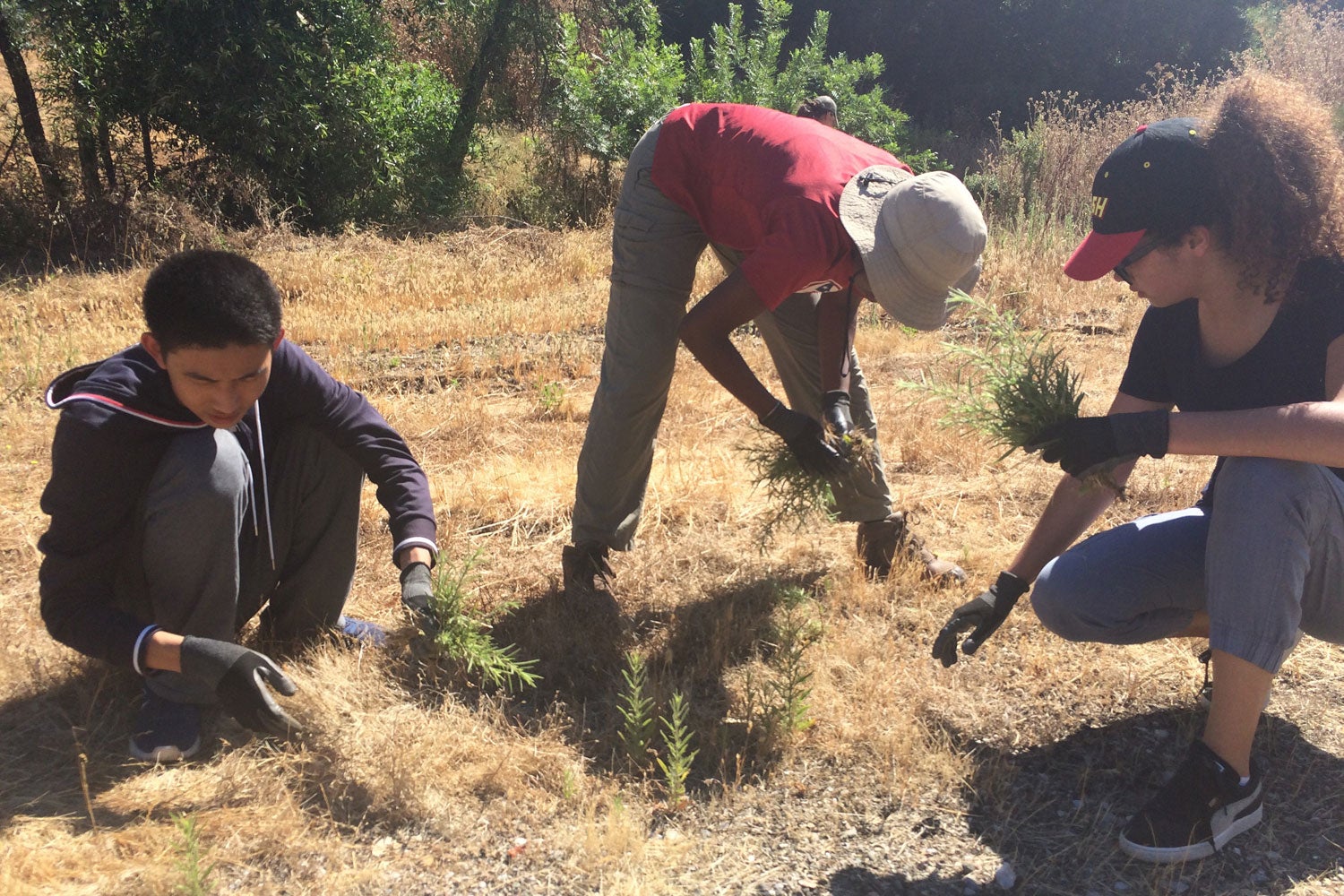Stanford’s Community Partnership Awards honor three service programs
Award winners are selected based on their initiative, leadership and involvement in projects that embody the spirit of genuine partnership and benefit the overall community.
Three community groups that are tackling real world problems and advancing the public good in neighboring cities have won Stanford’s 2017 Community Partnership Awards.

Stanford Summer Session students volunteer with Grassroots Ecology to remove invasive stinkwort. (Image credit: Courtesy Grassroots Ecology)
This year’s award winners are Grassroots Ecology, Laboratory Activities for Broadened Scientific Inquiry and Samaritan House Free Clinic of Redwood City.
Stanford’s Office of Public Affairs initiated the awards program to honor the valuable partnerships that exist between the university and its neighbors, and to celebrate community efforts that successfully tackle real world problems and advance the public good. David Demarest, vice president for public affairs, will present the awards at a private luncheon on Sept. 25.
Grassroots Ecology
Grassroots Ecology, which is based in Palo Alto, offers volunteer-based environmental stewardship programs across Silicon Valley, from the foothills of the Santa Cruz Mountains to the San Francisco Bay. Every year, Grassroots Ecology engages 10,000 people in hands-on habitat restoration, citizen science and educational programs.
At its Native Plant Nursery, the organization grows more than 30,000 plants of 200 locally native species from seeds and cuttings gathered within local watersheds, and then distributes them for reintroduction within those watersheds – playing a critical role in its efforts to rebuild healthy and functional natural habitat and preserve local biodiversity. All told, Grassroots Ecology oversees restoration activities in 22 sites around the peninsula, encompassing 2,600 acres of natural lands.
Grassroots Ecology has forged many partnerships with Stanford. The organization provides mentorships for students enrolled in the Open Space Management Practicum of the Earth Systems Program. Grassroots Ecology has conducted habitat restoration workdays with Stanford staff along sections of Matadero Creek and San Francisquito Creek that abut or are within Stanford lands. It has raised native plants for Stanford lands. In addition, Stanford staff and faculty have frequently participated in Grassroots Ecology’s Watershed Forum, providing insight and research to the public into watershed issues.
Laboratory Activities for Broadened Scientific Inquiry
Laboratory Activities for Broadened Scientific Inquiry (LABScI) creates fun experiments and science lessons – using easy-to-find materials – to teach science to middle school and high school students in non-traditional settings, such as hospital classrooms, hospital bedsides and home schools. For instance, in its “DNA Structure: Gumdrop Modeling Lab,” students build a DNA model using two bags of candy and a box of toothpicks. In its “Acoustics: The Sound Lab,” students use a slinky and a rubber-band guitar to learn about where sound comes from, how it travels and what changes a sound’s volume or pitch. Its labs – 30 different activities focused on chemistry, biology and physics – are available to the public on its website.
The project is a collaborative partnership between Stanford faculty and students, the Palo Alto Unified School District and Lucile Packard Children’s Hospital Stanford, which offers a fully accredited curriculum for hospitalized primary, middle and high school students.
Samaritan House Free Clinic of Redwood City
Samaritan House’s free clinic provides primary and specialty medical, dental and vision care to low-income and uninsured individuals in Redwood City.
The people who seek health care at Samaritan House, which also operates a free clinic in San Mateo, tend to earn just enough income to be ineligible for coverage under Medi-Cal – California’s Medicaid program for low-income individuals – yet do not receive health insurance through their employers and cannot afford to pay for “out-of-pocket” health insurance. Often, they are forced to seek treatment at local emergency rooms and become saddled with medical bills that they are unable to pay. Samaritan House fills this gap in health care access for the uninsured and saves emergency room resources for emergencies.
Each year, under a partnership with Stanford Medicine, Samaritan House hosts three medical students participating in a Continuity of Care Clerkship at its free clinic in Redwood City, as well as one to two undergraduate students who volunteer as patient advocates. On Saturdays, doctors, nurses and interpreters affiliated with Stanford Health Care Alliance volunteer at the clinic.
In addition, since 2010, Stanford Health Care’s Community Partnerships Program has provided annual grant funding to support a variety of clinic needs, including patient medications, supplies and health education materials; upgrades to exam rooms; and, most recently, a comprehensive diabetes treatment program.
